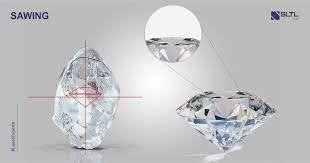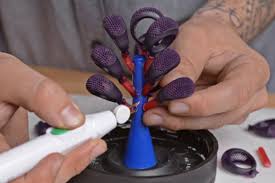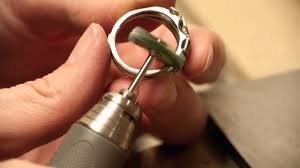Top Polisher- Diamond Processing
SECTOR: GEMS & JEWELLERY
SUB-SECTOR: Diamond processing
OCCUPATION: Faceting and polishing
REFERENCE ID: G&J/Q4702
ALIGNED TO: NCO-2015/NIL
Brief Job Description: The individual on the job works with top dop-tang system
and makes 32 top facets of a diamond by polishing it on a wheel or scaife in
order to yield maximum brilliance and symmetry. For polishing, the stone is set
either in a lead dop or a mechanical-clamp and held down on a revolving castiron scaife (horizontal and circular disc) charged with diamond dust. Also known
as Aanth (8) Pail Karigar or Mathala Karigar or Crown Polisher, the top polisher
creates the top 32 facets of a diamond.
Personal Attributes: The job requires the individual to have: attention to
details; good eyesight; steady hands; ability to work in a process driven team;
ability to work for long hours in sitting position on a bench or the floor; and a lot
of patience.
Keywords /Terms Description
Sector Sector is a conglomeration of different business operations having similar
business and interests. It may also be defined as a distinct subset of the
economy whose components share similar characteristics and interests.
Sub-sector Sub-sector is derived from a further breakdown based on the characteristics
and interests of its components.
Occupation Occupation is a set of job roles, which perform similar/ related set of functions
in an industry.
Job role Job role defines a unique set of functions that together form a unique
employment opportunity in an organisation.
Occupational Standards
(OS)
OS specify the standards of performance an individual must achieve when
carrying out a function in the workplace, together with the knowledge and
understanding they need to meet that standard consistently. Occupational
Standards are applicable both in the Indian and global contexts.
Performance Criteria Performance criteria are statements that together specify the standard of
performance required when carrying out a task.
National Occupational
Standards (OS)
NOS are occupational standards which apply uniquely in the Indian context.
Qualifications Pack (QP) QP comprises the set of OS, together with the educational, training and other
criteria required to perform a job role. A QP is assigned a unique qualifications
pack code.
Unit Code Unit code is a unique identifier for an Occupational Standard, which is denoted
by an ‘N’
Unit Title Unit title gives a clear overall statement about what the incumbent should be
able to do.
Description Description gives a short summary of the unit content. This would be helpful to
anyone searching on a database to verify that this is the appropriate OS they
are looking for.
Scope Scope is a set of statements specifying the range of variables that an individual
may have to deal with in carrying out the function which have a critical impact
on quality of performance required.
Knowledge and
Understanding
Knowledge and understanding are statements which together specify the
technical, generic, professional and organisational specific knowledge that an
individual needs in order to perform to the required standard.
Organisational Context Organisational context includes the way the organisation is structured and how
it operates, including the extent of operative knowledge managers have of their
relevant areas of responsibility.
Technical Knowledge Technical knowledge is the specific knowledge needed to accomplish specific
designated responsibilities.
Core Skills/ Generic
Skills
Core skills or generic skills are a group of skills that are the key to learning and
working in today’s world. These skills are typically needed in any work
environment. In the context of the OS, these include communication related
skills that are applicable to most job roles.
Keywords /Terms Description
NOS National Occupational Standard(s)
NSQF National Skills Qualifications Framework
QP Qualifications Pack
Unit Code G&J/N4701
Unit Title
(Task) Fix diamond in the pot
Description This OS unit is about fixing bruted/blocked diamond in the pot with accurate
alignment
Scope This unit/task covers the following:
Collecting the bruted/blocked diamond packet from the supervisor
Fixing the bruted/blocked diamond on the pot
Achieving productivity
Maintaining the quality of output
Performance Criteria(PC) w.r.t. the Scope
Element Performance Criteria
Collecting the
bruted/blocked diamond
packet from the
supervisor
To be competent, the user/individual on the job must be able to:
PC1. match the specifications of the diamonds such as shape, size and
quantity, as per those mentioned on the packet issued
Fixing the bruted/blocked
diamond on the pot
PC2. ensure accurate and secured fixing of diamond as per the polish required
PC3. ensure precise alignment and levelling of the diamond on the dop
Achieving productivity PC4. achieve the productivity in terms of carats or number of pieces as set by
the company
PC5. ensure timely delivery for further processing
Maintaining the quality of
output
PC6. ensure no damage to the diamond during fixing process
PC7. ensure no breakage while placing the cover in the press
Knowledge and Understanding (K)
A. Organizational
Context
The user/individual on the job needs to know and understand:
KA1. Company’s policies on: quality and delivery standards, safety and
hazards, integrity and personnel management
KA2. Non–disclosure of “confidential information” provided by the company
either orally or in writing marked as confidential
KA3. Liability arising out of loss, theft, or inadvertent disclosure of
confidential information
KA4. Work flow involved in company’s diamond processing process
KA5. Importance of the individual’s role in the workflow
KA6. Reporting structure
KA7. Issue return procedures followed by the company
B. Technical
Knowledge
The user/individual on the job needs to know and understand:
KB1. Shape, cut, clarity, carat, and physical characteristics of the diamond
KB2. How to select the pot as per the size, shape of the diamond and type of
polishing required (top pots for top polishing and bottom pots for
bottom polishing)
KB3. Techniques of fixing of diamonds on pot
KB4. How and when to use sticking agents i.e. lac, white agent, if required
KB5. Potential work hazards
KB6. Use of an eye glass in order to check alignment
Skills (S) [Optional]
A. Core Skills/ Generic
Skills
Writing Skills
The user/ individual on the job needs to know and understand how :
SA1. To Fill requisition slip for ordering consumables
Reading Skills
SA2. To read descriptions on the diamond packets/ bags
SA3. To document work done for status and performance appraisal
Oral Communication (Listening and Speaking skills)
SA4. To discuss task, schedules, and work-loads with co-workers and
supervisors
SA5. To understand instructions and report problems to supervisor
B. Professional Skills Decision Making
The user/ individual on the job needs to know and understand how :
SB1. Decide the plan for fixing the diamond on dop using lac or sticking
cement
Plan and Organize
SB2. Plan work for maximum productivity
Customer Centricity
N.A.
Problem Solving
SB3. To resolve the issues with the quality of the pot / cover being used
SB4. To resolve issues about mismatch of diamonds issued or received
Analytical Thinking
N.A.
Critical Thinking
SB5. To spot process disruptions and delays
Unit Code G&J/N4702
Unit Title
(Task) Make and polish the top facets of the diamond
Description This OS unit is about creating 32 top facets on diamond in the proportion, symmetry
and finish as per the planning or the objective fixed by the company
Scope This unit/task covers the following:
Setting up the polishing bench and fixing dop in tang
Creating crown facets on the diamond
Performing regular quality check of polish
Providing final finish to crown facets
Achieving Productivity
Reporting problems in time to avoid process disruptions
Performance Criteria(PC) w.r.t. the Scope
Element Performance Criteria
Setting up the
polishing bench and
fixing dop in tang
To be competent, the user/individual on the job must be able to:
PC1. set up polishing mill and achieve accurate levelling to remove vibrations
PC2. achive accurate alignment and fix the scaife on the bench
PC3. achieve accurate alignment and level tang plate with the scaife
PC4. prepare scaife for polishing
PC5. ensure precision in fixing and levelling the top dop onto the tang
Creating crown facets
on the diamond
PC6. understand the planning on the job sheet for the final finish of the diamond
PC7. polish the first four facets in such a way that a perfect square is created
PC8. Polish four main corner facets in such a way that a perfect octagon is created
and all facets are equal in shape and size
PC9. create 16 upper girdle facets
PC10. make the eight kite facets
PC11. apply diamond dust to the scaife as per instructions
Performing regular
quality check of
polish
PC12. repeatedly check the polish quality with the help of an eye glass
PC13. check the facets to exactly match with the plan
PC14. check and achieve accurate symmetry and the required dimensions &
Proportions such as crown height, crown angle, proportion and symmetry of
facets etc.
PC15. achieve finish and brilliance of the facets as planned
PC16. remove all the inclusions while polishing as per plan
PC17. achieve a cut grading up to the required standards
PC18. ensure accurate bagging and labelling of the diamonds before returning
Providing final finish
to crown facets
PC19. give a final finish to the diamond to achieve maximum brilliance, once the
exact faceting is done
PC20. ensure there are no problems like extra facets, natural surface, nicks,
scratches, polish lines, burning marks, abrasions, etc.
PC21. remove from the dye, clean the diamond and return to the issue department
after labelling the job packet/ bag
Achieving
productivity
PC22. achieve the productivity in terms of carats or number of pieces as per target
set by the company
PC23. achieve timely delivery for further processing
PC24. achieve minimize damage, weight loss and breakage
PC25. ensure zero flaws due to faulty polishing
Reporting problems
in the time to avoid
process disruptions
PC26. identify and report technical problems with any part of the bench/ mill such
as levelling, loose screws etc.
PC27. report planning defect
PC28. report any damage while polishing
Knowledge and Understanding (K)
A. Organizational
Context
The user/individual on the job needs to know and understand:
KA1. Company’s policies on: acceptable limits of weight loss; incentives; delivery
standards; safety practices and hazards; security and performance
measurement
KA2. Non–disclosure of “confidential information” provided by the company
either orally or in writing marked as confidential
KA3. Liability arising out of loss, theft, or inadvertent disclosure of confidential
information
KA4. Work flow involved in company’s diamond processing
KA5. Importance of the individual’s role in the workflow
KA6. Reporting structure
KA7. Issue return procedures followed by the company
KA8. Typical customer profile and market trends
KA9. Specialization area of the company (size, clarity, shape, quality, etc. of
diamonds)
KA10. Diamond processing objective of the company, e.g. maximizing yield,
maximizing clarity, etc.
B. Technical
Knowledge
The user/individual on the job needs to know and understand:
KB1. Blocking procedure of diamonds
KB2. Cleaning of scaife
KB3. Bruting and coning
KB4. Polishing process
KB5. 4Cs of diamond (colour, cut, clarity and carat)
KB6. Use of various scopes in diamond processing
KB7. Stress (tension) of the diamond
KB8. Using proportion and symmetry analyzer machine
KB9. Geometry to understand the angles and symmetry
KB10. Direction of the tang and using the data system on the tang
KB11. Process of preparation of scaife
KB12. Level of fluorescence and its treatments
KB13. Repair work
KB14. Valuation of diamonds depending on different dimensions
KB15. Knowledge of assembly of different parts of the bench
KB16. Knowledge of levelling the scaife and plate
KB17. Knowledge of preparing the scaife for polishing
KB18. Knowledge of levelling the tang
KB19. To know uses of different types of tools and materials for different purposes
and end results
KB20. To know how to maintain and prepare the tools as per job requirement
KB21. To know potential work hazards, particularly, when using machine tools
Skills (S) [Optional]
A. Core Skills/
Generic Skills
Writing Skills
The user/ individual on the job needs to know and understand how to:
SA1. Document work done for status and performance appraisal
Reading Skills
SA2. To read descriptions on the job packets/ bags
SA3. To read the dimensions specified by the proportion analyser machine
Oral Communication (Listening and Speaking skills)
SA4. Discuss task lists, schedules, and work-loads with co-workers and supervisor
SA5. To understand instructions and report problems
SA6. To share work load as required
SA7. To assist others who require help
SA8. To share knowledge with co-workers
SA9. To work with other people sharing the bench
SA10. To work in other departments such as bottom polishing, girdle, handling the
complete diamond
B. Professional Skills Decision Making
The user/ individual on the job needs to know and understand how to:
SB1. Make decisions pertaining to use right tang, the correct level and direction to
achieve the desired finish
Plan and Organize
SB2. To plan work for maximum productivity
SB3. To plan the best cut to get maximum value from the diamond
SB4. To plan to improve speed of polishing while maintaining facet’s proportion,
symmetry and weight loss as per planning
Problem Solving
SB5. Rectify defects occurred
Analytical Thinking
SB6. To devise new means of working to improve productivity or reduce efforts
SB7. To suggest improvements in tools/machines for productivity or better quality
Critical Thinking
SB8. To spot process disruptions and delays
Unit Code G&J/N9901
Unit Title
(Task) Coordinate with others
Description This OS unit is about communicating with colleagues, seniors and outside parties in
order to achieve the deliverables on schedule
Scope This unit/task covers the following:
Interacting with supervisor
Interacting with colleagues within and outside the department
Interacting with outside parties
Performance Criteria(PC) w.r.t. the Scope
Element Performance Criteria
Interacting with
supervisor
To be competent, the user/individual on the job must be able to:
PC1. coordinate for receiving work instructions and raw materials from reporting
supervisor
PC2. communicate to the reporting supervisor about process flow improvements,
product defects received from previous process, repairs and maintenance of
tools and machinery as required
PC3. communicate to reporting supervisor about operation details and hazards
PC4. interact with supervisor regarding compliance of company policy and rules
Interacting with
colleagues within and
outside the
department
PC5. coordinate with colleagues to share work, as per the workload
PC6. communicate and discuss work flow related difficulties in order to find
solutions with mutual agreement
PC7. coordinate and receive feedback from quality control department
PC8. coordinate for putting team goals over individual goals
PC9. resolve conflicts by communicating with colleagues and other departments
PC10. coordinate with colleagues regarding multitasking in other departments with
requirements
Interacting with
outside parties
PC11. adhere to nondisclosure policy of the company in all outside coordination
Knowledge and Understanding (K)
A. Organizational
Context
The user/individual on the job needs to know and understand:
KA1. Company’s policies on: preferred language of communication, reporting and
escalation policy, quality delivery standards, and personnel management
KA2. Company’s policies on non-disclosure of “confidential information” provided
by the company either orally or in writing marked as confidential
KA3. Liability arising out of loss, theft, or inadvertent disclosure of confidential
information
KA4. Reporting structure
B. Technical
Knowledge
The user/individual on the job needs to know and understand:
KB1. Various categories of people that one is required to communicate and
coordinate within the organization
KB2. Importance of effective communication in the workplace
KB3. Importance of teamwork in organization and individual success
KB4. Various components of effective communication
KB5. Key elements of active listening
KB6. Barriers to effective communication
KB7. Importance of avoiding casual expletives and unpleasant terms while
communicating professional circles
KB8. To avoid Common reasons for interpersonal conflict
KB9. Expressing and addressing grievances appropriately and effectively
KB10. What constitutes disciplined behavior for a working professional
Skills (S) [Optional]
A. Core Skills/
Generic Skills
Writing Skills
The user/ individual on the job needs to know and understand how to:
SA1. Write instructions, remarks, job sheets, basic information, technical details
etc. in preferred local language of communication and English
Reading Skills
SA2. Read preferred language of communication as prescribed by the company
SA3. Read job sheets and interpret technical details mentioned in the job sheet
Oral Communication (Listening and Speaking skills)
SA4. Discuss task lists, schedules, and work-loads with co-workers
SA5. Be a good listener
SA6. Be effective in communicating the issues faced to the supervisor
SA7. Avoid using jargon, slang or acronyms when communicating
B. Professional Skills Decision Making
The user/ individual on the job needs to know and understand how to:
SB1. Spot and communicate potential areas of disruptions to work process and
report the same
SB2. Report to supervisor and or to deal with a colleague individually, depending
on the type of concern
Plan and Organize
SB3. Collate information and communicate in a manner that is clear and
comprehensive to colleagues and supervisor
SB4. Convey accurate information to all internal as well as external customers (or
right information to right person)
Problem Solving
SB5. How to handle critical situations caused due to communication issues at
workplace and solve problems without blaming others
Analytical Thinking
SB6. Analyse the work processes by interacting with others and adopting best
practices
SB7. Use prior experience to observe and reflect for development of ideas
Critical Thinking
SB8. Think through the problem, evaluate the possible solution(s) and suggest an
optimum /best possible solution(s)
SB9. Deal with clients lacking the technical background to solve the problem on
their own
SB10. Spot process disruptions and delays and report and communicate with
solutions
SB11. Identify immediate or temporary solutions to resolve delays
SB12. Apply, analyze, and evaluate the information gathered from observation,
experience, reasoning, or communication, as a guide to thought and action
Unit Code G&J/N9902
Unit Title
(Task) Maintain health and safety at workplace
Description This OS unit is about being aware of, communicating and taking steps towards
minimizing potential hazards and dangers of accidents on the job and maintaining
health and safety
Scope This unit/task covers the following:
Health and safety in work area
Fire safety
Emergencies, rescue and first aid procedures
Performance Criteria(PC) w.r.t. the Scope
Element Performance Criteria
Health and safety in
work area
To be competent, the user/individual on the job must be able to:
PC1. identify and use appropriate protective clothing/equipment for specific tasks
and work
PC2. identify hazardous job activities in his/her job and communicate the possible
causes of risks or accidents in the workplace
PC3. carry out safe working practices while dealing with hazards to ensure safety
of self and others
PC4. identify and avoid doing any tasks or activities in a bad working position
PC5. practice appropriate working postures to minimise occupational health
related issues
Fire safety PC6. use the appropriate fire extinguishers on different types of fire
PC7. dDemonstrate rescue techniques applied during fire hazard
PC8. demonstrate good housekeeping in order to prevent fire hazards
PC9. demonstrate the correct use of any fire extinguisher
Emergencies, rescue
and first aid
procedures
PC10. administer appropriate first aid procedure to victims wherever required eg.in
case of bleeding, burns, choking, electric shock etc.
PC11. respond promptly and appropriately to an accident situation or medical
emergency
PC12. participate in emergency procedures such as raising alarm, safe evacuation,
correct means of escape, correct assembly point etc.
Knowledge and Understanding (K)
A. Organizational
Context
The user/individual on the job needs to know and understand:
KA1. Company’s policies on: safety and hazards and personnel management
KA2. Names and location of documents that refer to health and safety in work
place
KA3. Reporting structure
B. Technical
Knowledge
The user/individual on the job needs to know and understand:
KB1. Meaning of “hazards” and risks
KB2. Health and safety hazards commonly present in the work place and related
precautions
KB3. Various dangers associate with use of electrical equipment
KB4. Preventative and remedial actions to be taken in case of exposure to toxic
material
KB5. Methods of accident prevention
KB6. How different chemicals react and what could be the danger from them
KB7. How to use machines and tools without causing any harm to the body
KB8. Importance of using protective clothing/ equipment while working
KB9. Precautionary activities to prevent the fire accident
KB10. Various causes of fire
KB11. Techniques of using different fire extinguishers
KB12. Different materials used for extinguishing fire
KB13. Rescue techniques applied during a fire hazard
KB14. Various types of safety signs and what they mean
KB15. Appropriate basic first aid treatment relevant to condition e.g. bleeding minor
burns eye injuries
KB16. Potential impact to a person who is moved incorrectly
Skills (S) [Optional]
A. Core Skills/
Generic Skills
Writing Skills
The individual on the job needs to know and understand how to:
N.A.
Reading Skills
SA1. Read and comprehend basic content to read labels, charts, signage’s
SA2. Read and comprehend basic English to read manuals of operations
Oral Communication (Listening and Speaking skills)
SA3. Effectively communicate the risk of not following safety measures
B. Professional Skills Decision Making
The individual on the job needs to know and understand how to:
SB1. Report potential sources of danger
SB2. Follow the relevant prescribed procedure in the event of an accident
SB3. Wear appropriate safety gear to avoid an accident
Plan and Organize
SB4. Learn from past mistakes regarding use of hazardous machines or chemicals
N. A.
Problem Solving
SB5. Adhere to and guide others to follow prescribed procedures related to health
and safety
Analytical Thinking
SB6. Analyse untoward incidents from the past and implement correct use of
machines, tools or hazardous chemicals
Critical Thinking
SB7. Critically analyse the processes carried out by self and by colleagues in the
department to spot potential hazards and safety issues
Criteria For Assessment Of Trainees
Job Role Top Polisher-Diamond Processing
Qualification Pack G&J/Q4702
Sector Skill Council Gem & Jewellery
Guidelines for Assessment
- Criteria for assessment for each Qualification Pack will be created by the Sector Skill Council. Each Performance
Criteria (PC) will be assigned marks proportional to its importance in NOS. SSC will also lay down proportion of
marks for Theory and Skills Practical for each PC. - The assessment for the theory part will be based on knowledge bank of questions created by the SSC.
- Assessment will be conducted for all compulsory NOS, and where applicable, on the selected elective/option
NOS/set of NOS. - Individual assessment agencies will create unique question papers for theory part for each candidate at each
examination/training center (as per assessment criteria below). - Individual assessment agencies will create unique evaluations for skill practical for every student at each
examination/training center based on this criterion. - To pass the Qualification Pack , every trainee should score a minimum of 50% of aggregate marks to successfully
clear the assessment. - In case of unsuccessful completion, the trainee may seek reassessment on the Qualification Pack.








